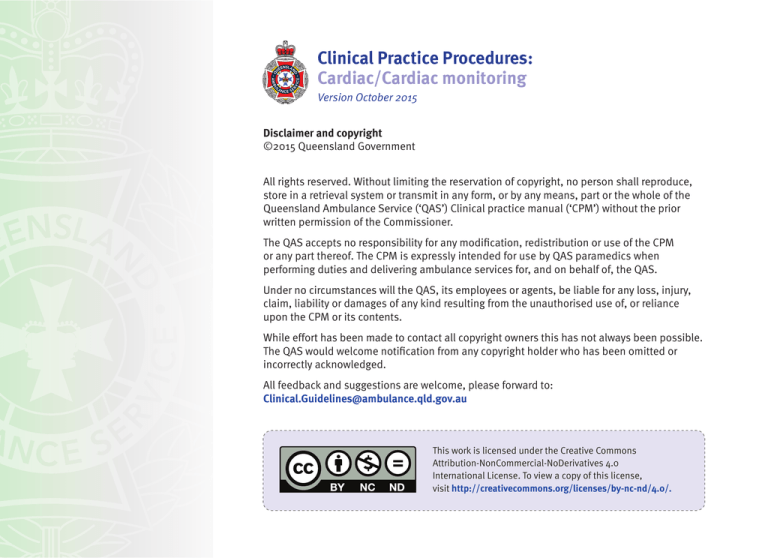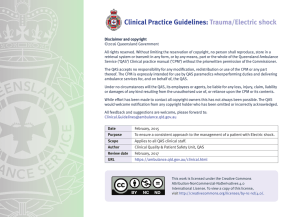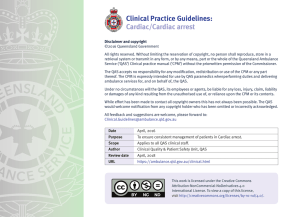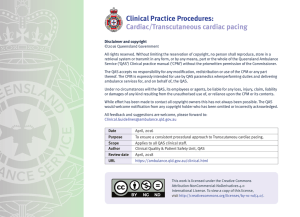
Clinical Practice Procedures:
Cardiac/Cardiac monitoring
Version October 2015
Disclaimer and copyright
©2015 Queensland Government
All rights reserved. Without limiting the reservation of copyright, no person shall reproduce,
store in a retrieval system or transmit in any form, or by any means, part or the whole of the
Queensland Ambulance Service (‘QAS’) Clinical practice manual (‘CPM’) without the prior
written permission of the Commissioner.
The QAS accepts no responsibility for any modification, redistribution or use of the CPM
or any part thereof. The CPM is expressly intended for use by QAS paramedics when
performing duties and delivering ambulance services for, and on behalf of, the QAS.
Under no circumstances will the QAS, its employees or agents, be liable for any loss, injury,
claim, liability or damages of any kind resulting from the unauthorised use of, or reliance
upon the CPM or its contents.
While effort has been made to contact all copyright owners this has not always been possible.
The QAS would welcome notification from any copyright holder who has been omitted or
incorrectly acknowledged.
All feedback and suggestions are welcome, please forward to:
Clinical.Guidelines@ambulance.qld.gov.au
This work is licensed under the Creative Commons
Attribution-NonCommercial-NoDerivatives 4.0
International License. To view a copy of this license,
visit http://creativecommons.org/licenses/by-nc-nd/4.0/.
Cardiac monitoring
October, 2015
Continuous cardiac monitoring records the electrical activity of the
heart as an electrocardiogram (ECG) both on the monitor screen and on printed ECG paper.
Contraindications
UNCONTROLLED WHEN PRINTED
Cardiac monitoring is indicated for the identification of potentially
lethal dysrhythmias and to provide real time feedback to paramedics
regarding the electrical activity of the myocardium.
ST segment analysis via the monitor screen is unreliable, and may be distorted. Therefore ST segment analysis for the purpose of
determining AMI must be performed using a printed ECG that has
been acquired at diagnostic frequencies. Note: The VF/VT alarm
should always be turned on.
• Nil in this setting
Complications
Be aware of potential artefacts in the ECG from:[1] UNCONTROLLED WHEN PRINTED
Indications
Cardiac monitoring is essential in the following patient groups, though not limited to:
• Detached electrodes due to diaphoresis, oily skin, or chest hair
• Patient movement, breathing, muscle tremor or lead movement
• AC electricity/50 hertz interference
UNCONTROLLED WHEN PRINTED
• All unconscious patients or collapse patients
• Recently unconscious patients
• Poisoned patients
• Patients presenting with chest pain or dyspnoea
• Patients who are poorly perfused / shocked
• Broken cable tip, wire or machine malfunction
• Dry electrode conductive gel
Note: If the patient’s condition progresses into cardiac arrest, any electrodes impeding the proper application of the defibrillator pads must be removed.
UNCONTROLLED WHEN PRINTED
• Patients with hypoxia or with abnormal vital signs
• When a medical officer requests the patient to be monitored
Figure 3.49
• Patients suffering a cardiac arrest (may be monitored through defibrillation pads)
QUEENSLAND AMBULANCE SERVICE
485
Procedure – Cardiac monitoring
• Explain to the patient the procedure, obtain
consent and ensure privacy where possible.
UNCONTROLLED WHEN PRINTED
• Clean the surface of the skin to ensure
monitoring electrodes will adhere.
• It may also be necessary to:
- Shave the chest hair if necessary
- Prepare the skin by removing oil or moisture
where able.
UNCONTROLLED WHEN PRINTED
• Inspect the monitoring electrode pad to ensure
that the surface is sufficiently adhesive.
• Attach the electrodes to the monitoring leads.
• Remove the backing of the electrode and apply to the patient’s skin.
• Smooth the electrode from one edge to the other to ensure a correct application.
UNCONTROLLED WHEN PRINTED
• The monitoring electrodes for the limb leads
are generally placed distally on limbs (distal
placement). Where reduction in motion artefact
and electrical interference is required it is
acceptable to place all the limb electrodes proximally (proximal placement), as follows:
UNCONTROLLED WHEN PRINTED
- LA (black) and RA (white) electrodes are
placed proximally on the arms but not on the torso
- LL (red) and RL (green) electrodes are placed
proximally, but no higher than the illiac crest.
QUEENSLAND AMBULANCE SERVICE
486





